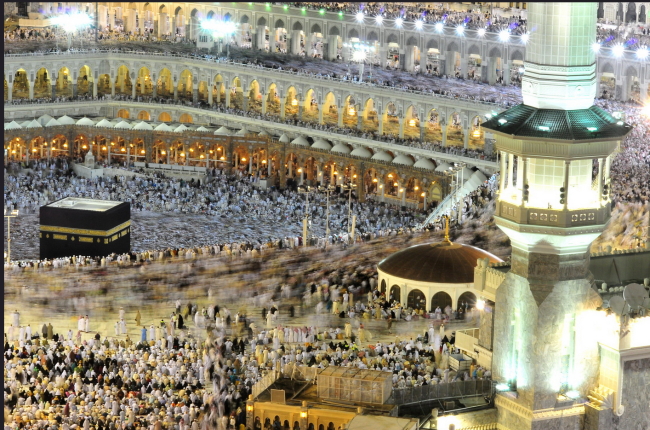SUNSET THURSDAY, JULY 7: One million Muslim pilgrims have been pouring into Mecca from across the globe, preparing for a journey most have anticipated their entire lives: Today begins the annual pilgrimage that is Hajj.
To complete one of the five pillars of Islam, Muslims must visit Mecca and fulfill the Hajj rituals that reenact the actions of the Prophet Muhammad in his “farewell pilgrimage,” in 632 AD.
Arriving via every mode of transportation available and from countries that span the globe, this annual Islamic pilgrimage is widely considered the largest annual gathering in the world.
NEWS UPDATES: In 2019, Saudi Arabia allowed approximately 2.5 million Muslim pilgrims to participate in Hajj; during the past two years, only a few thousand were permitted. This year, approximately 1 million pilgrims will be permitted to perform the Hajj. In addition, while increasing the numbers, the kingdom’s Ministry of Hajj and Umrah said the annual Muslim pilgrimage would only be allowed for pilgrims who have been fully vaccinated against COVID-19 and are under the age of 65. (Read more in the Aljazeera.)
Still, Deputy Minister of Hajj and Umrah Abdul Fattah Mashat reported that Hajj, as well as Umrah—a shorter pilgrimage that can be performed at any time of the year—are major components of the Saudi Vision 2030, which aims to boost the religious tourism sector and host 30 million Umrah pilgrims annually by 2030. (Read more in The National.
PILGRIMAGE TO MECCA: AN ANCIENT JOURNEY
The Hajj pilgrimage is regarded as a religious duty that must be undertaken by every adult Muslim at least once in his or her lifetime—if that person has the mental, physical and financial ability to make the long journey. Despite the word “duty,” Muslims regard Hajj as an experience to be treasured. The ritual of a pilgrimage to Mecca actually stretches back centuries before the advent of Islam—to the time of Ibrahim (Abraham)—yet it was the Islamic prophet Muhammad who cemented the rituals of Hajj in the seventh century. The uniform method of performing the rituals of Hajj is meant to demonstrate both the solidarity of the Muslim people and their submission to Allah (God).
THE ORIGINS OF HAJJ: ABRAHAM, HAGAR & ISHMAEL
Islamic tradition tells that in approximately 2000 BCE, Abraham was ordered by God to leave his wife, Hagar, and his son, Ishmael, in the desert of Mecca while he traveled to Canaan. After Abraham left, food and water quickly ran out; Hagar ran back and forth between the hills of Safa and Marwa seven times. Exhausted, Hagar laid Ishmael on the sand and begged God for help. Miraculously, a well sprang up at the baby’s feet, and that well—the Zamzam Well—continues to provide ample water to Hajj pilgrims today. Later, according to Muslim tradition, Abraham was commanded to build the Kaaba, so that people could perform pilgrimage there. It is believed that the Archangel Gabriel brought the Black Stone from heaven to be attached to the Kaaba, and today, the Black Stone marks the beginning and ending point of each circle a pilgrim makes as he circulates the Kaaba during Hajj.
Jahiliyyah: During a time known as jahiliyyah in pre-Islamic Arabia, the Kaaba had become surrounded by pagan idols. To cleanse the Kaaba, the Prophet Muhammad led his followers from Medina to Mecca in what is now regarded as the first Hajj. The pagan idols were destroyed, and Muhammad rededicated the Kaaba to God. At this point, Hajj became one of the five pillars of Islam, and adherents have been making the journey ever since.
PILGRIMAGE RITUALS:
THE GRAND MOSQUE, MOUNT ARAFAT AND THE ZAMZAM WELL
Before the start of Hajj, pilgrims bathe, don special clothing and make a statement of intent at the entry station. The first ritual of Hajj is performed inside the Grand Mosque complex: pilgrims circle the Kaaba structure seven times, counterclockwise, reciting prayers (tawaf). Following tawaf, many drink from the Zamzam well. Next, Muslim pilgrims walk rapidly between the hills of Sara and Marwa seven times, as Hagar did (al-Sai). Another statement of intent is made, after which the faithful travel through Mina, and on to the plains of Mount Arafat.
Intense prayer for forgiveness is offered at Arafat, as Muhammad said, “Far more people are freed from the Hellfire on the Day of Arafat than on any other day.” This portion of the Hajj journey is one of the most important. Small stones are gathered, and the following day, pilgrims perform a symbolic “stoning of the devil” at Mina (rami).
from Religious Holidays https://ift.tt/r1xtJKp

 :: Unlock Your Success with Our Digital Course →
:: Unlock Your Success with Our Digital Course →














No comments:
Post a Comment